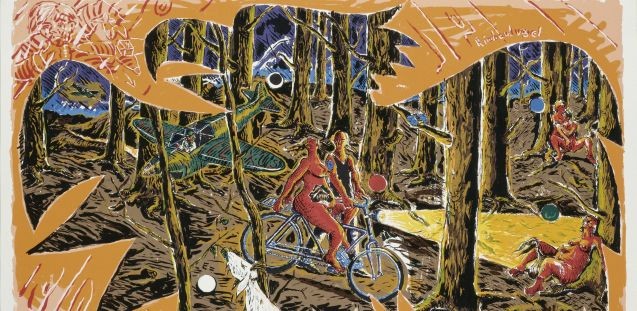Jörg Immendorff
18 Mar - 13 Jul 2014

Jörg Immendorff (1945-2007)
Rimbaudvogel, 1993 Siebdruck, Ex.42/60
Foto: bpk / Staatliche Museen zu Berlin, Kupferstichkabinett / Jochen Littkemann
Rimbaudvogel, 1993 Siebdruck, Ex.42/60
Foto: bpk / Staatliche Museen zu Berlin, Kupferstichkabinett / Jochen Littkemann
JÖRG IMMENDORFF
Prints
18 March - 13 July 2014
To coincide with the exhibition "Expansion of the Combat Zone, 1968-2000, the Collection Part 3" at the Neue Nationalgalerie, the Kupferstichkabinett is displaying selected prints by the German artist Jörg Immendorff (d. 2007 Düsseldorf) that range in date from 1982 to 1993.
In 1982, the artist featured in the important "erste konzentration" portfolio, published by Galerie Maximilian - Sabine Knust in Munich, with a total of six works (linocuts, lithographs, and silk screens). During a period of resurgence of figurative painting in Western Europe and the United States, Immendorff became one of its key figures in Germany, along with Georg Baselitz and Markus Lüpertz.
His artistic career started in the 1960s, with his studies at the Kunstakademie Düsseldorf under Joseph Beuys, during which time he became artistically and politically active in the "LIDL actions" of 1968. Immendorff was influenced by Beuys' active questioning of artistic convention, carrying on the practice in his own painting in the 1970s and 1980s. As his technically diverse prints show, he developed a visual language that contained a wide range of symbols and references to historical and contemporary people and events.
Throughout the 1980s, the ideological and social conflict between East and West played an important role in his work. The conflict articulated itself in the nuclear arms race and, most visibly, in the division of Germany. The division had a direct effect on Immendorf, notably in his friendship with Dresden artist A.R. Penck, who lived in the GDR until 1984 and who Immendorff met for the first time in 1976 in East Berlin. (Penck's lithography "Übergang" is on display in the exhibition.)
From the late 1980s, Paris became a recurring motif in Immendorff's work, representing for him an artistic and intellectual centre of post-war Modernism, as demonstrated in several large screen prints originally published by Berlin gallerist Clemens Fahnemann. His interest in Paris is particularly evident in his "Café de Flore", which includes portraits of various artists - amongst them a number from Penck's Düsseldorf circle.
Prints
18 March - 13 July 2014
To coincide with the exhibition "Expansion of the Combat Zone, 1968-2000, the Collection Part 3" at the Neue Nationalgalerie, the Kupferstichkabinett is displaying selected prints by the German artist Jörg Immendorff (d. 2007 Düsseldorf) that range in date from 1982 to 1993.
In 1982, the artist featured in the important "erste konzentration" portfolio, published by Galerie Maximilian - Sabine Knust in Munich, with a total of six works (linocuts, lithographs, and silk screens). During a period of resurgence of figurative painting in Western Europe and the United States, Immendorff became one of its key figures in Germany, along with Georg Baselitz and Markus Lüpertz.
His artistic career started in the 1960s, with his studies at the Kunstakademie Düsseldorf under Joseph Beuys, during which time he became artistically and politically active in the "LIDL actions" of 1968. Immendorff was influenced by Beuys' active questioning of artistic convention, carrying on the practice in his own painting in the 1970s and 1980s. As his technically diverse prints show, he developed a visual language that contained a wide range of symbols and references to historical and contemporary people and events.
Throughout the 1980s, the ideological and social conflict between East and West played an important role in his work. The conflict articulated itself in the nuclear arms race and, most visibly, in the division of Germany. The division had a direct effect on Immendorf, notably in his friendship with Dresden artist A.R. Penck, who lived in the GDR until 1984 and who Immendorff met for the first time in 1976 in East Berlin. (Penck's lithography "Übergang" is on display in the exhibition.)
From the late 1980s, Paris became a recurring motif in Immendorff's work, representing for him an artistic and intellectual centre of post-war Modernism, as demonstrated in several large screen prints originally published by Berlin gallerist Clemens Fahnemann. His interest in Paris is particularly evident in his "Café de Flore", which includes portraits of various artists - amongst them a number from Penck's Düsseldorf circle.
